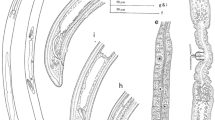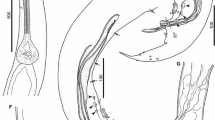Abstract
Timmiella goaense gen. n., sp. n. closely related to genera Swangeria Thorne, 1939, Qudsiella Jairajpuri, 1967 and Timmus Goseco, Ferris and Ferris, 1976 is described and illustrated based on specimens collected from Western Ghats of India. The new genus is characterized by its broadly rounded, continuous lip region; odontostyle short, delicate with indistinct lumen and aperture; guiding ring thick belt-like, conspicuous; anterior part of pharynx slender, a narrow tube; expanded part of pharynx fusiform, enclosed by sinistrally spiral muscular sheath; cardia isthmus-like (spatulate) with intestine attached to its posterior end; female genital system amphidelphic; vulva transverse; male with dorylaimoid spicules; tail long filiform, similar in both sexes.


Similar content being viewed by others
References
Ahmad M, Jairajpuri MS (1978) Oxybelondira n. gen. (Dorylaimida: Oxydiridae) with description of two new species. Ind J Nematol 8:25–31
Ahmad W, Jairajpuri MS (1982) Studies on the genus Axonchium Cobb, 1920 from India. Nematologica 28:21–33. https://doi.org/10.1163/187529282X00484
Andrássy I (1976) Evolution as a basis for the systematization of nematodes. Pitman Publication Ltd., London, UK
Andrássy I (2009) Free-living nematodes of Hungary, (Nematoda errantia). Vol. III. Pedozoologica Hungarica No. 5. Hungarian Natural History Museum, Budapest
Clark WC (1961) A revised classification of the order Enoplida (Nematoda). N Z J Sci 4:123–150
Clark WC (1964) Falcihasta palustris n. gen. et. sp., Family Belondiridae (Nematoda). N Z J Sci 7:177–180
Cobb NA (1918) Estimating the nema population of the soil. United States Department of Agriculture, Bureau of Plant Industry, Agriculture Technical Circular 1:1–48
Coomans A, Kheiri A (1986) Observations on Lindseyus costatus Ferris & Ferris, 1973 with a discussion on its relationships (Nematoda: Belondiridae). Rev Nematol 9:357–367
Courtney WD, Polley D, Miller VL (1955) TAF, an improved fixative in nematode technique. Plant Dis Report 39:570–571
De Ley P, Blaxter ML (2002) Systematic position and phylogeny. In: Lee DL (ed) The biology of nematodes, Taylor and Francis, London, UK, pp 1–30
De Man JG (1876) Onderzoekingen over vrij in de aarde levende nematoden. Tijdschrift Nederlandsche Dierkundige Vereeniging 2:78–196
De Maeseneer J, d’Herde J (1963) Méthodes utilisées pour l’étude des anguillules libres du sol. Rev Agricult Bur 16:441–447
Dhanam M, Jairajpuri MS (1998) New belondirid nematodes: two new genera, two new subgenera and seven new species from Malnad tracts of Karnataka, India. Ind J Nematol 8:193–213
Ferris VR, Ferris JM (1973) Lindseyus costatus gen. n., sp. n., and notes on the Roqueidae and Swangeriidae (Nematoda: Dorylaimida). Proc Helminthol Soc Wash 40:43–46
Filipjev IN (1934) The classification of free-living nematodes and their relation to parasitic nematodes. Smithson Misc Coll 89:1–63
Goseco CG, Ferris VR, Ferris JM (1976) Revisions in Leptonchoidea (Nematoda: Dorylaimida). Dorylaimoides in Dorylaimoididae, Dorylaimoidinae; Calolaimus and Timmus n. gen. in Dorylaimoididae, Calolaiminae; and Miranema in Miranematidae. Res Bull Agric Exp Statn Purdue Univ West Lafayette 941:1–46
Jairajpuri MS (1964) Studies on Nygellidae n. fam. and Belondiridae Thorne, 1939 (Nematoda: Dorylaimoidea) with description of ten new species from India. Proc Helminthol Soc Wash 31:173–187
Jairajpuri MS (1967) Qudsiella gracilis n. gen., n. sp. (Nematoda: Dorylaimida) from Andamans, India. Nematologica 12:587–590. https://doi.org/10.1163/187529266X00437
Jairajpuri MS, Ahmad M (1978) Some remarks on the genus Oxydirus Thorne 1939 with proposal of Paraoxydirus n. gen. Ind J Nematol 8:146–148
Jairajpuri MS, Ahmad M (1980) Revised classification of the superfamily Belondiroidea Thorne, 1964 with notes on the systematics of Dorylaimellus Cobb, 1913 (Nematoda: Dorylaimida). Ind J Nematol 10:9–22
Jairajpuri MS, Ahmad W (1992) Dorylaimida free-living, predaceous and plant-parasitic nematodes. E. J. Brill, Leiden, Holland
Kumar S, Ahmad W (2021) Two new and two known species of the genus Paraoxydirus Jairajpuri and Ahmad, 1978 (Nematoda: Dorylaimida) from Western Ghats of India. Helminthologia 3:292–314. https://doi.org/10.2478/helm-2021-0028
Kumar S, Ahmad W (2022) Qudsialemellus keralaensis gen. et sp. nov. (Nematoda: Dorylaimida: Belondiridae) from Western Ghats of India. Annal Zool 72:195–201. https://doi.org/10.3161/0003454ANZ2022.72.2.003
Loof PAA, Coomans A (1970) On the development and location of the oesophageal gland nuclei in the Dorylaimina. In: Proc. IX Int. Nem Symp, Warsaw, 1967, pp 79–161
Mittermeier RA, Gil PR, Hoffman M, Pilgrim J, Brooks T, Mittermeier CG, Lamoreux J, Da Fonseca GAB (2004) Hotspots revisited: Earth’s biologically richest and most endangered ecoregions. CEMEX Mexico city, Mexico
Mulk MM, Coomans A, Baqrl QH (1978) A taxonomic revision of the nematode species described by S. Stekhoven and Teunissen (1938) from National Virunga Park, Zaire Republic. III Belondiridae. Rev Zool Afr 92:711–722
Myers N, Mittermeier RA, Mittermeier CG, Da Fonesca GAB, Kent J (2000) Biodiversity hotspots for conservation priorities. Nature 403:853–858. https://doi.org/10.1038/35002501
Nair P, Coomans A (1973) The genus Axonchium (Nematoda: Belondiridae). 1. Morphology, juvenile stages, diagnosis and list of species. Nematologica 18:495–513. https://doi.org/10.1163/187529272X00106
Peña-Santiago R, Abolafia J, Álvarez-Ortega S (2014) New proposal for a detailed description of the dorylaim spicule (Nematoda: Dorylaimida). Nematology 16:1091–1095. https://doi.org/10.1163/15685411-00002834
Peña-Santiago R (2006). Dorylaimida part 1: Superfamilies Belondiroidea, Nygolaimoidea and Tylencholaimoidea - In: Eyualem-Abebe, Transpurger W, Andrássy I (eds) Freshwater nematodes: Ecology and Taxonomy, CABI, Wallingford, UK, pp 326–391
Seinhorst JW (1959) A rapid method for the transfer of nematodes from fixative to anhydrous glycerin. Nematologica 4:67–69
Siddiqi MR (1968) Five new species of Belondiroidea (Nematoda) from Sibsagar, India with a revised classification of the superfamily. Proc Helminthol Soc Wash 35:248–258
Siddiqi MR (1981) Six new genera of dorylaimid nematodes. Nematologica 27:397–421
Thorne G (1939) A monograph of the nematodes of the superfamily Dorylaimoidea. Capita Zool 8:1–261
Thorne G (1964) Nematodes of Puerto Rico: Belondiroidea, new superfamily, Leptonchidae Thorne, 1934 and Belonenchidae new family (Nematoda, Adenophorea, Dorylaimida). Univ Puerto Rico Agr Exp Sta Tech Paper 39:1–51
Yeates GW (1967) Studies on nematodes from Dune sands. Dorylaimoidea. N Z J Sci 10:752–784
Acknowledgements
The authors are thankful to the Chairman, Department of Zoology for providing necessary laboratory facilities. The first author also thanks the University Grants Commission, Govt. of India for providing UGC-RGNF Fellowship.
Author information
Authors and Affiliations
Corresponding author
Ethics declarations
Conflict of interest
No conflict of interest.
Additional information
Publisher's note
Springer Nature remains neutral with regard to jurisdictional claims in published maps and institutional affiliations.
Rights and permissions
Springer Nature or its licensor (e.g. a society or other partner) holds exclusive rights to this article under a publishing agreement with the author(s) or other rightsholder(s); author self-archiving of the accepted manuscript version of this article is solely governed by the terms of such publishing agreement and applicable law.
About this article
Cite this article
Kumar, S., Ahmad, W. Timmiella goaense gen. n., sp. n. (Nematoda: Dorylaimida: Belondiroidea) from Western Ghats of India. Biologia 78, 1059–1065 (2023). https://doi.org/10.1007/s11756-023-01314-9
Received:
Accepted:
Published:
Issue Date:
DOI: https://doi.org/10.1007/s11756-023-01314-9




